3-Point Checklist for Small Businesses Developing a Minimum Viable Product
Everyone loves startup success stories. But we can often learn more from the stories of small businesses that fail at building the perfect product.
A [CB Insight study](https://www.cbinsights.com/research/startup-failure-reasons-top/) that looked at 101 failed startups found t**he leading cause of failure among startups is building products for which there is no market need.**
To overcome this challenge, startups and small businesses should adopt what’s known as a minimum viable product methodology.
Releasing an MVP instead of a full-featured product eliminates the risk of launching a product that’s too early or too late for the market, according to Gartner’s “Tech Go-to-Market: Five Steps to Validate a New Tech Product Idea” report (full content available to clients).
However, businesses need to be cautious about using the MVP mindset correctly. Gartner advises that the misapplication of the MVP approach will result in businesses wasting valuable resources and time.
Beyond wasting resources, the release of a not fully fleshed-out and untested minimum viable product can land small businesses in the midst of expensive lawsuits, as well as tarnish their reputation.
Don’t forget about the infamous Microsoft chatbot, Tay, which was taken offline after sending out a series of offensive tweets. Or how the Federal Trade Commission fined Luminosity $2 million for launching an incomplete product backed by fake advertisements that preyed on consumers’ fears.
Small businesses like yours can’t afford to make these mistakes, so the best strategy is to learn from the above mistakes and avoid such instances. To help you out, this article looks at how small businesses can overcome common challenges to develop a successful minimum viable product.
(Note: The MVP approach is applicable to businesses delivering physical products, software products or services, but in this report, we’re focusing on SaaS [Software-as-a-Service] products.)
Here’s what we’ll cover:
Strategy Is Key to Your MVP’s Success or Failure
3-Point Checklist for Developing the Minimum Viable Product
1. Test Your Idea Before You Actually Build the Product
2. Build a Complete and Customer-Centric Product
3. Test the Pricing of Your Minimum Viable Product
Strategy Is Key to Your MVP’s Success or Failure
Determining whether a market exists for your product can be a challenge. In a MindTheProduct survey, 49 percent of product managers say that conducting research to “validate” the market need of a product is their biggest challenge.
Businesses can overcome the difficulties of dealing with unreliable market research using the minimum viable product strategy.
As a lean project management concept, the MVP technique allows agile software development companies to quickly build and release products that will satisfy early adopters, but takes the least amount of time and resources. The full product is released over time, based on the insights from early adopter feedback.
Here’s a three-point checklist you should use to inform your strategy for developing a minimum viable product.
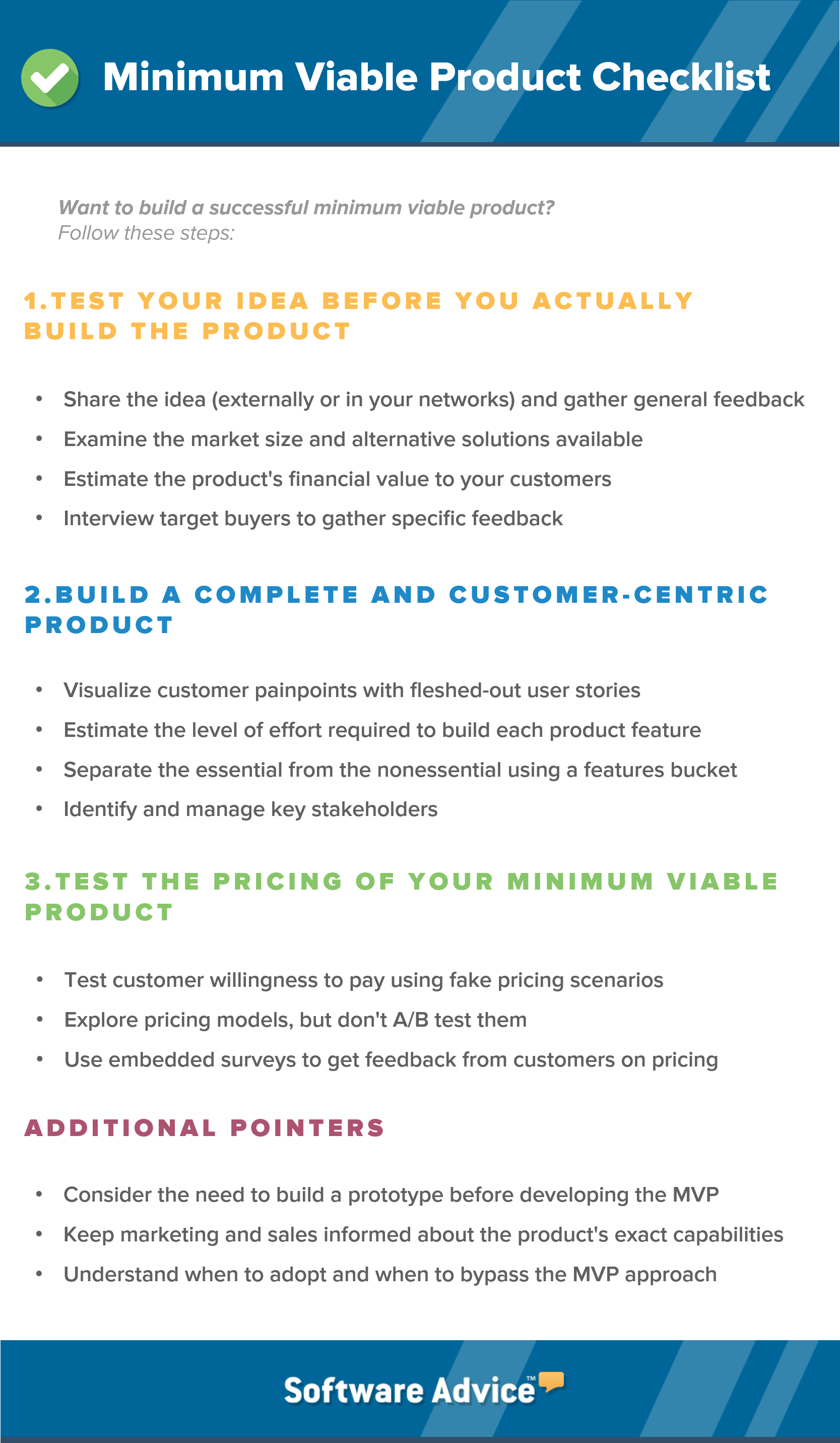
1. Test Your Idea Before You Actually Build the Product
Why you can’t skip this step: In pursuit of the minimum viable product, product managers are often tempted to forgo market research completely. As a result, they are likely to overestimate the product’s potential. This can result in failure to explore alternative solutions and examine the competitor landscape.
Small businesses should validate the product idea before developing the MVP, so they don’t waste valuable resources and time building a product for which there’s no market need.
How can SMBs do this: A popular example of product idea validation is when Joe Gascoigne (founder and CEO of Buffer) created a pricing page asking customers to sign up for a social media management tool that hadn’t been built yet. When Joe saw genuine interest from customers, he went on to build and successfully launch the product’s minimum viable version.
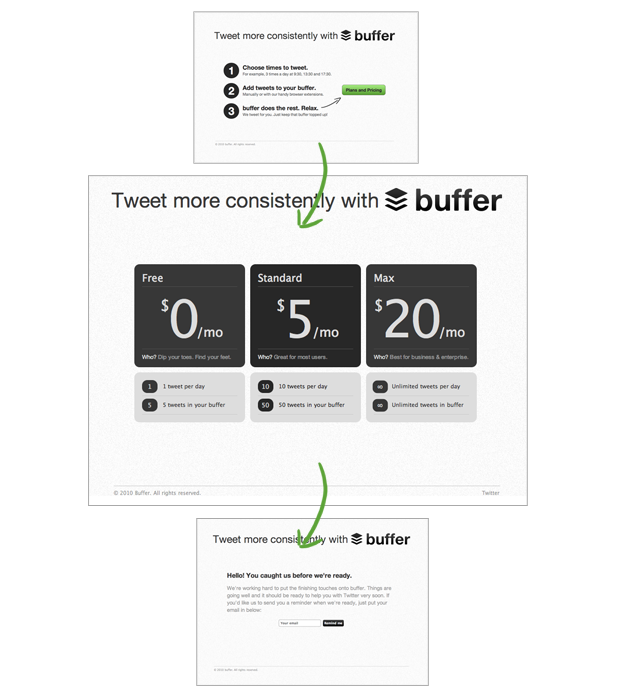
Product idea validation (Source)
Here are four recommendations from Gartner’s report (full content available to clients) that small business product managers can follow to test the product idea before developing the MVP:
Share the idea (externally or in your networks) and gather general feedback: This step is about gathering critical feedback (not necessarily from potential customers) to gauge the need for your product. Collecting feedback on B2C products could be as simple as walking into Starbucks and questioning strangers. In a B2B setting however, confidentiality is a prerequisite; therefore, it’s a good practice to share your idea with only professional networks.
Examine the market size and availability of alternative solutions: You need to do this to understand the strengths and weaknesses of alternative solutions and your market competition. Make detailed notes about the market size, the pricing of similar products, technological advances in the market and so on.
Estimate the product’s financial value to your customers: Financial value is a key driver that can set your MVP apart from the alternative solutions. It’s crucial to know exactly how to price your product (more on this later). Building an affordable solution was the success mantra behind Girish Mathrubootham’s (founder and CEO of Freshdesk) minimum viable product, which acquired 100 customers in the first three months.
Interview target buyers to gather specific feedback: The final step is to directly ask your target audience about the challenge your product will solve and how much they’d pay for such a solution. You can use online communities such as Quora and LinkedIn, as well as small business market research tools.
2. Build a Complete and Customer-Centric Product
Why you can’t skip this step: The rush to do an MVP doesn’t mean that businesses should hastily release incomplete and untested products.
Henrik Kniberg, a lean/agile coach, calls this “bastardized agile.” He illustrates this approach with the metaphor that businesses developing the first version of a software product must at least deliver a “skateboard” and not a “tire,” when the final product is supposed to be a “car.”
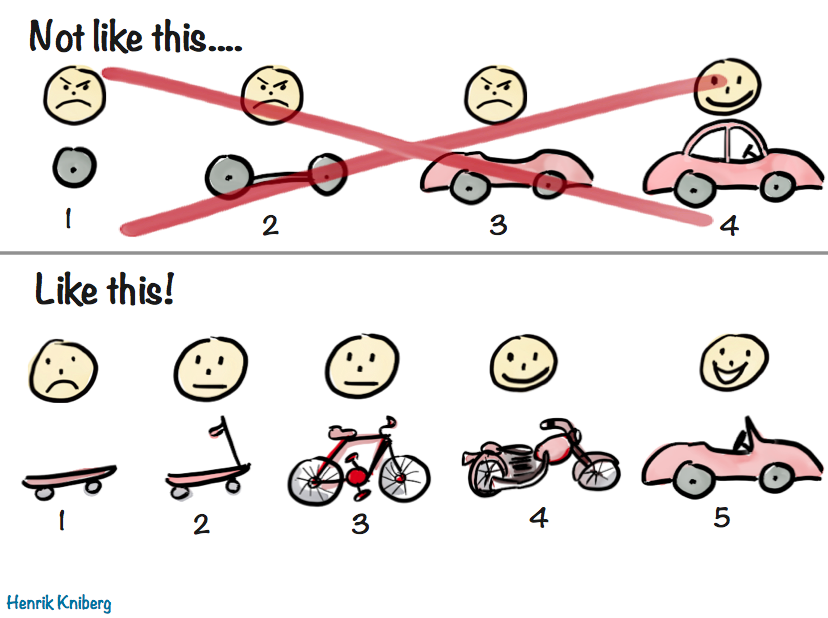
Henrik Kniberg’s drawing of an MVP process (Source)
Small businesses that rush the MVP will receive negative feedback from its early adopters, leading to considerable delays in launching the next version of the product.
How can SMBs do this: Building a complete product, in the MVP sense, means prioritizing those features that offer the most value to your earliest customers. Feature prioritization should be centered around the core requirements of these customers; anything beyond that should be slated as a future release in your product roadmap.
Here are four recommended strategies to use when prioritizing features for a minimum viable product:
Visualize customer painpoints with fleshed-out user stories: A typical user story focuses on who the customer is, what feature they want and why they want it. Building rich customer personas and adding details of the value customers get from the feature helps you build better user stories. However, product managers should avoid adding too many details, such as explaining how to build the feature, as this shifts the focus from understanding customer problems to describing the functionality.
Estimate the level of effort required to build the feature: Prioritizing what feature to build depends on your budget and resources. As a small business, focus first on developing those features that require the least effort and offer the greatest value to users. Teams can assign points to a user story that can help correctly estimate the impact of the feature and the effort required to build it.
Separate the essential features from the nonessential ones using a features bucket: Another way to prioritize features is building a features bucket that has four compartments: must-have, should-have, could-have and won’t-have. Known as the MoSCow method, the technique will help you prioritize features for the MVP and visualize the product roadmap for future iterations.
Identify and manage key stakeholders: The MVP should serve the needs of the target customers. However, certain groups or individuals within your small business can have sway over the development of the minimum viable product. To counter this, product managers should implement a project stakeholder management strategy to ensure that these stakeholders don’t become roadblocks to the product.
3. Test the Pricing of Your Minimum Viable Product
Why you can’t skip this step: Finding paying customers for your minimum viable product is irrefutable proof that it serves a market need. Dale Gordon (Lecturer of Technology Entrepreneurship, University of Maryland) says that a minimum viable product is successful only if it makes customers want to pay for it, immediately.
However, there’s always a danger of customers finding your product overpriced, especially if your competitors offer a similar product for free. SMBs should experiment with different strategies such as testing fake pricing and pricing models to mitigate the risks of overpricing.
How can SMBs do this: Experimentation is the key word when it comes to getting your MVP pricing right. Mathilde Collin, CEO and co-founder of Front, says that the secret behind their SaaS product pricing is testing out incremental changes every three weeks.
Small businesses should focus on finding the easiest and lowest risk ways to test their MVP pricing. Here are some tips on how to go about it.
Test customer willingness to pay with fake pricing scenarios: Testing the willingness of customers to buy your MVP doesn’t always mean you actually have to charge them for it. Instead, try creative strategies, like what Cory Zue did. The aspiring entrepreneur and former CTO of Dimagi used fake pricing for his minimum viable product—a printable place card maker. He offered numerous paid and free card templates, and at the end of the funnel, customers who selected the paid templates were told that they would get the card for free! Zue also saved on the days or weeks it would have taken him to on set up a payment gateway.
Explore pricing models, but don’t A/B test them: The A/B test of offering two pricing pages works for more established products. However, with an MVP product where there are only a few customers initially, the lessons learned from an A/B test will be minimal. Instead, you can look at different pricing models. Freemium is a popular model with SaaS products, though you could also go for flat-rate product or 3-tiered Goldilocks pricing. Just remember to find a model that suits your MVP and stick with it for at least three weeks.
Use embedded surveys to get feedback from customers on pricing: Using survey tools, you can get direct feedback from your target customers about your product’s pricing. Embed the survey on the pricing page so that it pops up to ask users to rate the value they get out of the features. You can also include direct questions, such as whether they think your product is expensive compared to similar products in the market. This is an easy and effective way to test if you’ve gotten the product pricing right.
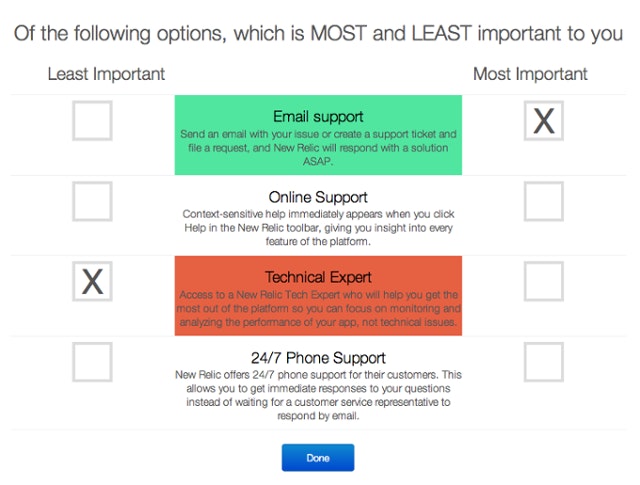
PriceIntelligently’s customer value-rating example survey (Source__)
Conclusion and Next Steps
Besides the three best practices above, there are many more considerations for developing a minimum viable product.
For instance, SaaS startups can visualize their minimum viable product better by building a prototype first.
In addition, be sure sales and marketing teams are well-informed about the exact capabilities of the minimum viable product. The wrong messaging can cause a public backlash when an overhyped product fails to deliver on its promises.
Last but not the least, small businesses should remember that, at times, they would be better off not developing a minimum viable product. Check out the graphic below, which lays out the key scenarios for when a business should adopt or bypass an MVP approach.
Recommended Use of an MVP
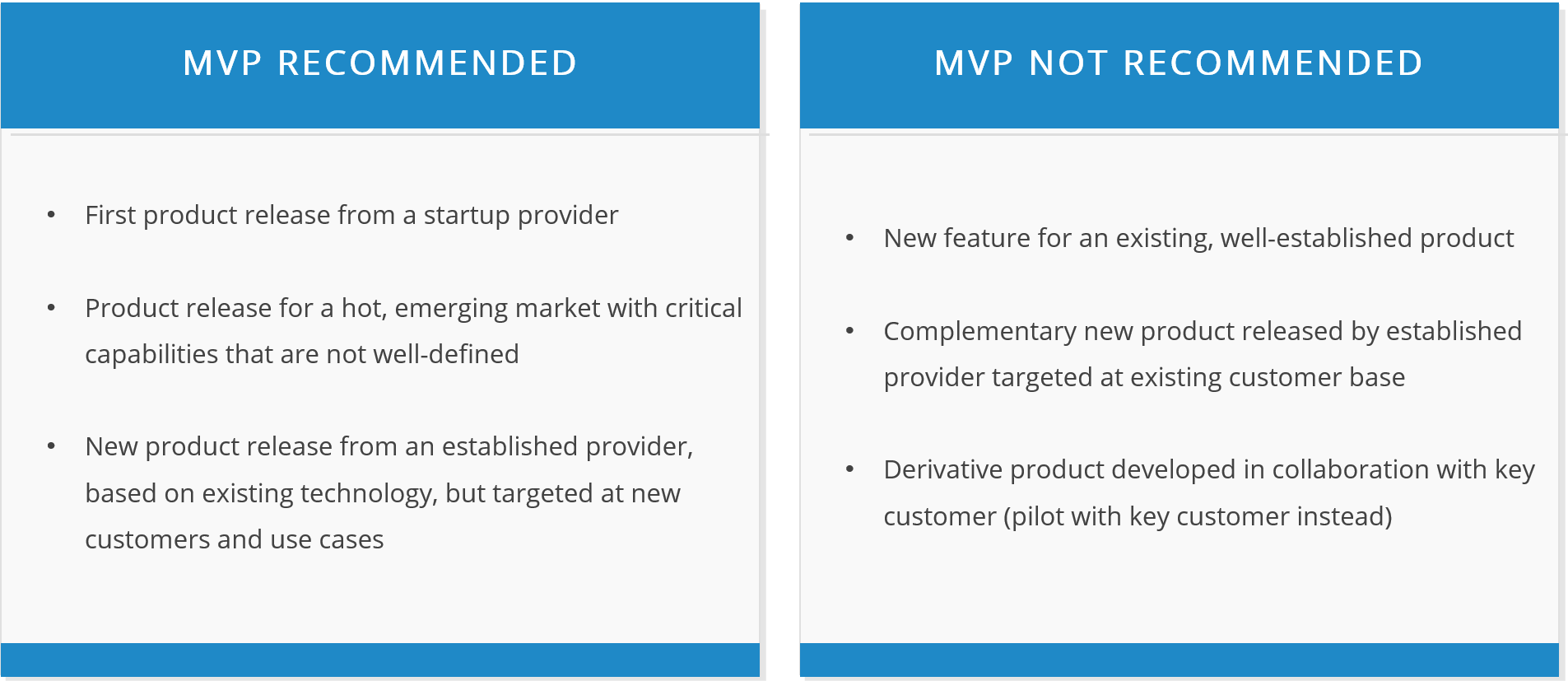
A version of this image originally appeared in “Tech Go-to-Market: How to Apply the Minimum Viable Product Approach to Improve New Product Success” (Content available to Gartner clients)
Companies developing an MVP will need specialized project management tools. Check out our reports and buyer guides that describe the features, pricing and uses of agile project management tools such as:
And for more information on the best tools, or to discuss your queries and questions, reach out to our advisors at (844) 680-2046 for a free consultation.